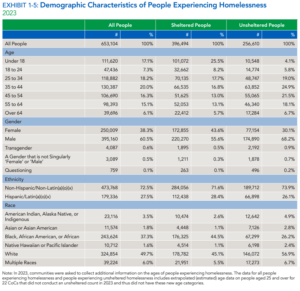You may have seen news reports about the growing incidence of homelessness in the U.S. In particular, one of the demographics that is growing in number is homeless older adults. There are a number of factors that are contributing to this troubling trend. What can we as a nation do to help ensure older members of our population are able to live with dignity and a sense of long-term security in a safe home?
In December of last year, the U.S. Department of Housing and Urban Development (HUD) released their 2023 Annual Homelessness Assessment Report (AHAR) to Congress. Each year, Part I of this report provides a point-in-time (PIT) estimate of the number of homeless people in the nation on a night in the last week of January.
Based on data collected this past January, over 653,000 people – roughly 20 of every 10,000 people in the country – experience homelessness. Of those, 6 in 10 people are experiencing what is referred to as “sheltered homelessness” meaning they are living in an emergency shelter, transitional housing, or a safe haven program. The other 4 in those 10 are experiencing unsheltered homelessness, which means they are living in places that are not intended to be inhabited by humans.
The HUD report found that between 2022 and 2023, the number of homeless people in our country increased by 12%, or approximately 70,650 people. Perhaps even more troubling, 2023’s PIT count was the highest number of people reported as experiencing homelessness on a single night since reporting began in 2007, reflecting the increase in our nation’s homeless population.
>> Related: A Little-Known Detail about Medicaid Qualification and Paying for Long-Term Care
An increase in homeless older adults
The HUD report delves into the demographics of our homeless population as well, revealing additional concerning data.
Among the most troubling statistics were those related to the number of homeless older adults. In fact, the HUD report found that “more than 1 in 5 people experiencing homelessness on a single night in [late January] 2023 was age 55 or older. More than 98,000 people experiencing homelessness were aged 55 to 64, and almost 39,700 people were over age 64. Nearly half of those adults age 55 or older (46%) were experiencing unsheltered homelessness in places not meant for human habitation.”
Further breaking down these figures, the report found that among all homeless people in the U.S. in 2023, 15.1% or nearly 98,400, were age 55 to 64. Another 6% or nearly 39,700 people were over the age of 64. These two age groups make up a combined 18.8% of sheltered homeless people, but homeless older adults make up almost a quarter (24.8%) of those who are unsheltered.

Source: 2023 Annual Homelessness Assessment Report (AHAR) to Congress
>> Related: The Impact of Socioeconomics on Positive Aging
More homeless Veterans
Another troubling set of statistics from the HUD report: Over 35,570 Veterans — adults of any age who served on active duty in the U.S. armed forces including Reserves and National Guard — were among those dealing with homelessness. That is a staggering 22 out of every 10,000 Veterans in our country. That’s also a 7% rise — or 2,445 more homeless Veterans from 2022 to 2023. These figures include a 14% increase in the number of unsheltered Veterans, or 1,943 more people, and a 3% uptick in the number of Veterans who are among the sheltered homeless (502 more people).
Interestingly, more than 7 out of 10 unsheltered homeless Veterans were located in one of these five states:
- California (48%)
- Florida (7%)
- Washington (6%)
- Oregon (6%)
- Texas (5%)
The states with the fewest unsheltered homeless Veterans were New York and Wisconsin at 3% each.
While most would argue that no Veteran should be among the homeless in our nation, there is one positive finding among the HUD data. The researchers found that, “Despite increases in experiences of Veteran homelessness between 2022 and 2023, the number of Veterans experiencing homelessness is 52% lower than it was in 2009, the baseline year for reporting Veterans experiencing homelessness in the AHAR.”
>> Related: Paying for Senior Living- Know Your Options
Factors in the homelessness increase
There are many factors that are contributing to the rising number of homeless people of all ages in our nation, including the growing number of homeless older adults. To name a few:
- Lack of affordable housing: Particularly in some of the nation’s larger cities, there is not enough supply of affordable housing to keep up with demand, particularly for families and older adults who may be on a fixed income.
- Increased rents, home costs, and interest rates: Because demand is often outpacing supply, rent and home prices have also gone up alongside record-high mortgage interest rates. Again, for older people with a fixed income, such increases can be financially catastrophic.
- End of pandemic-era safety nets: Funds set aside by the American Rescue Plan Act (ARPA) to help people experiencing homelessness or at risk of homelessness have dried up or expired. Similarly, the federal moratorium on evicting people for non-payment of rent or mortgages has ended, forcing some older people out of their homes.
- Growing number of migrants and asylum-seekers: The influx of migrants and asylum-seekers crossing the nation’s southern border have created even larger numbers of homeless people, as well as more people vying for the lower-cost housing that many older people rely upon..
- Climate change and natural disasters: As the planet warms and produces more severe and extreme weather, more people are being left homeless by hurricanes, flooding, snowstorms, tornadoes, and wildfires. For example, California and Florida, which are home to more older people per capita than any two other states, have experienced a number of natural catastrophes that have left people homeless.
- Addiction: The nation’s growing number of addicts — fueled by not only alcohol but powerful drugs like prescription opioids, methamphetamine, and fentanyl — is adding to the number of people experiencing homelessness. And older people are not immune to addiction with studies showing 8% of Medicare beneficiaries under age 65 and 2% of those age 65 and older report having some type of substance use disorder.
>> Related: Combatting the Invisible Epidemic of Substance Abuse Among Older Adults
Solving the homeless older adults crisis
As a nation, we must find practical solutions for the rising number of people experiencing homelessness, perhaps especially vulnerable populations like homeless older adults and children, as well as our Veterans. It is necessary and it is our moral mandate.
The 2023 AHAR report from HUD did show that the national inventory of beds for people experiencing homelessness increased by 7% from 2022 to 2023. That is a step in the right direction, however given that the number of homeless people increased by 12% in that same period, we need to do more and do it quickly.
Indeed, our older population deserves to live in safe housing that allows them to enjoy their lives without worrying about their home being ripped from under them (literally or figuratively). Could the solution be more subsidized senior housing options? Or perhaps a permanent voucher program to support care programs and housing solutions for our nation’s homeless older adults?
We would challenge the senior living industry to consider innovative solutions that might be both cost-effective and make a meaningful impact on the number of homeless older adults in our nation.

FREE Detailed Profile Reports on CCRCs/Life Plan Communities
Search Communities






